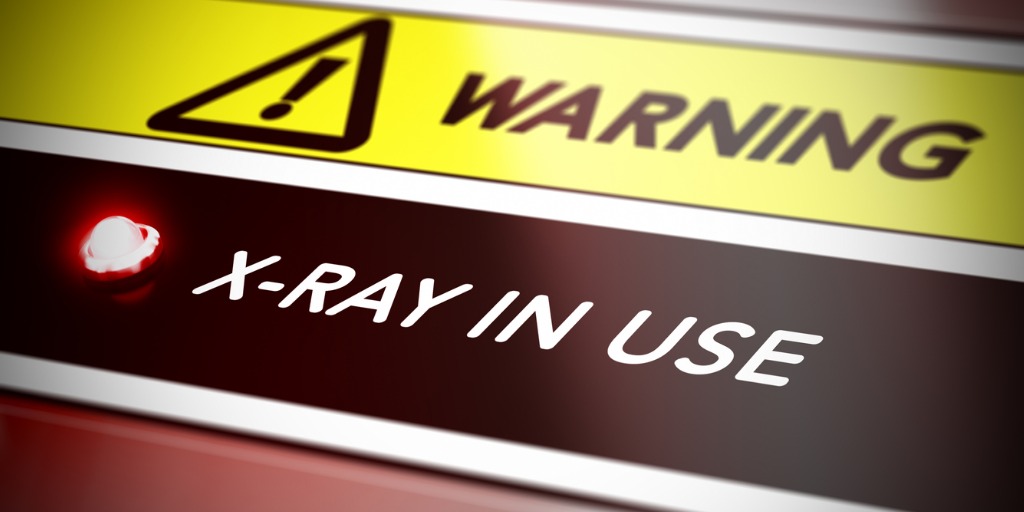
Certain types of glass offer excellent shielding against various types of radiation, making them indispensable for applications in medicine and the nuclear industry. In this article, we take a look at some of the most common applications of radiation-shielding glass, and the ways in which glass can be modified to shield against radiation.
History of Glass Radiation Shielding
Discovery of x-rays by Roentgen in 1895 was followed by a flurry of x-ray research: around 1000 x-ray research papers were published within a single year. Unfortunately, scientists of the time were late to establish that x-rays were capable of damaging living tissue. By the end of 1896, numerous cases of x-ray dermatitis and more serious conditions were reported within the scientific community.1
Though the risks of radiation exposure were not quickly accepted, radiation shielding equipment was developed as early as 1896. Many of these early interventions made use of lead glass to absorb radiation: These included lead glass backings for fluorescent screens, and thick lead glass goggles to protect against cataracts.
Glass as a Radiation Shield
Today, lead glass and other types of specialized glass are considered vital materials for protection against radiation exposure. As well as offering tunable mechanical, chemical and optical properties, glasses that contain lead strongly absorb gamma, x-ray, and neutron radiation. This unique set of properties makes glass an invaluable radiation shield for applications where line-of-sight is required, such as in medical radiography and nuclear fuel processing.
In many of these applications, radiation-shielding glass finds use in the form of containers known as hot cells and gloveboxes. Both are shielded containers with radiation-proof glass viewing windows, used for the safe storage and manipulation of radioactive materials. Hot cells are more thoroughly shielded heavy-duty containers used for high-intensity radiation sources such as spent nuclear fuel rods. Gloveboxes are used for lower intensity radiation sources such as certain radiopharmaceuticals.
In other areas, screens and windows made from radiation-shielding glass protect healthcare workers and researchers from x-ray sources such as spectrometers and computed tomography (CT) scanners.
Heavy Metal Oxide Glass Modifiers
In general, glasses used for radiation-shielding applications include heavy metal oxide (HMO) modifiers such as lead oxide (PbO) and bismuth oxide (Bi2O3). These chemicals can turn ordinary silicate glass into transparent radiation shields capable of effectively absorbing neutrons, gamma rays and x-rays. The resulting glasses are capable of attenuating radiation at levels comparable to concrete and other standard shielding materials while allowing visible light to pass through.2 Crucially, HMO glasses experience relatively little optical or mechanical degradation as a result of exposure to radiation.
While glasses containing lead oxide are common, increasing the lead content leads to a reduction in both melting point and hardness of the glass.2 This, along with environmental concerns with the use of lead, has encouraged research into other types of HMO glass for radiation shielding applications. These include oxides of boron, tellurium, barium, and silicon.3,4 Some research suggests that these glasses may be able to replace conventional concretes as gamma-ray shielding materials.
Medicine
One key application of radiation-shielding glass is in nuclear medicine. Radioactive sources or materials are used either for imaging purposes (such as positron emission tomography (PET) scans) or therapeutic use (such as radiation therapy). Hot cells and gloveboxes are widely used in the preparation of radiopharmaceuticals, where they allow personnel to process radioactive substances without exposure to dangerous amounts of radiation. Material handling is achieved with the use of remote manipulators or shielded gloves, while radiation-shielded glass windows allow personnel to see inside.
Radiographers are also at risk of exposure to harmful radiation. While scans such as x-rays are generally considered acceptably safe for use in the diagnosis of medical conditions, radiographers carrying out multiple scans per day rely on radiation shielding to minimize their exposure to radiation. Leaded glass windows can strongly absorb both x-rays and gamma rays, allowing radiographers to oversee x-ray or PET scans without exposing themselves to harmful levels of radiation.
Nuclear
Effective radiation shielding is of paramount importance throughout the nuclear industry. Nuclear reactors, spent fuel rods, and fission byproducts all produce many types of harmful radiation in large quantities. Some of these types of radiation are more easily shielded than others: for example, alpha and beta radiation are easily shielded by a thin layer of aluminum or acrylic. However, other radiation types such as gamma, x-ray, and neutron emission can be more challenging to protect against.
Typically, these types of radiation are attenuated by thick concrete shielding. However, in waste reprocessing and laboratory applications, windows of radiation-shielding glass can be used to enable workers to safely view radioactive materials during processing.
Other Applications
Radiation-shielding glass is used in many other applications throughout research and industry, for example in cyclotron maintenance, non-destructive materials testing, and the construction of airport x-ray machines.5 Glass is also used for radiation shielding in space technology for protecting both humans and equipment from cosmic rays — an application for which Mo-Sci is currently developing a lightweight radiation-shielding glass.
References and Further Reading
- Brodsky, A., Consultants, A. B. & Ronald, M. Historical Development of Radiation Safety Practices in Radiology.
- Manohara, S. R., Hanagodimath, S. M. & Gerward, L. Photon interaction and energy absorption in glass: A transparent gamma ray shield. J. Nucl. Mater. 393, 465–472 (2009).
- Lakshminarayana, G. et al. B2O3–Bi2O3–TeO2–BaO and TeO2–Bi2O3–BaO glass systems: a comparative assessment of gamma-ray and fast and thermal neutron attenuation aspects. Appl. Phys. A Mater. Sci. Process. 126, 1–18 (2020).
- Singh, K. J., Kaur, S. & Kaundal, R. S. Comparative study of gamma ray shielding and some properties of PbO-SiO2-Al2O3 and Bi2O3-SiO2-Al2O3 glass systems. Radiat. Phys. Chem. 96, 153–157 (2014).
- Manonara, S. R., Hanagodimath, S. M., Gerward, L. & Mittal, K. C. Exposure Buildup Factors for Heavy Metal Oxide Glass: A Radiation Shield. J. Korean Phys. Soc. 59, 2039–2042 (2011).
